Next week the Syrian conflict will enter its seventh year. What began in March 2011 as an uprising against the rule of President Bashar al-Assad turned into a civil war before metastasising into a proxy war that drew in all the regional powers.
With its myriad factions and their foreign sponsors locked in a cycle of mutually assured stalemate, a pattern of remorseless escalation took hold, with catastrophic consequences.
In the past six years an estimated 400,000 Syrians have been killed, according to the United Nations. More than 4.8 million refugees have fled the country, seeking safety in Turkey, Lebanon, Jordan and beyond. A further 6.3 million are displaced internally, meaning that almost half of Syria's prewar population have been forced to flee their homes.
As illustrated in a new report by the aid agency Concern this week, many of those who remain face grinding hardship: food and power shortages, aerial bombardment, a collapsed economy and, in pockets in the east, brutal rule at the hands of Islamic State.
An end to hostilities remains some way off, although the events of recent months may well have brought the endgame into view. The theatre of war is contracting: fighting is now heavily concentrated in northern Syria, a trend partly attributable to battlefield gains by the Assad regime and its Russian ally.
In December Assad's forces claimed an important symbolic and strategic prize by retaking Aleppo, Syria's largest prewar city, after a long battle in which, according to a UN report published last week, both sides committed war crimes.
For the Syrian president, in retreat and on the defensive less than two years ago, military advances have coincided with political good fortune. The new US president is not Hillary Clinton, who advocated a no-fly zone in northern Syria, but Donald Trump, who sounds agnostic about Assad remaining in power and has yet to set out a policy on the long-running conflict.
Assad can also count on diplomatic support from powerful allies. A recent investigation by the UN and the Organisation for the Prohibition of Chemical Weapons found that Syrian government forces were responsible for three chlorine-gas attacks. When western powers moved to impose sanctions on Damascus at the UN Security Council Russia and China blocked the attempt by casting their vetoes.
Islamic State, meanwhile, is in retreat on the battlefield. As it mounts a ferocious defence of Mosul, by far its most significant possession in Iraq, the jihadist group continues to suffer losses across northeastern Syria. In recent days the Syrian army forced Islamic State – also known as Isis – out of the ancient city of Palmyra for a second time.
Even more significantly, US-backed militias have severed the main road between Raqqa, Islamic State’s de-facto capital, and its stronghold of Deir al-Zor. The advance means all main roads out of Raqqa are now cut.
A shaky ceasefire has been in place since December, but the only real hope of a resolution to the civil war rests on two parallel rounds of peace talks taking place in Geneva and Astana, the capital of Kazakhstan.
The Astana talks, sponsored by Russia and Iran, are focused on military questions, while the Geneva process, the latest round of which ended without a breakthrough last month, is focusing on the political questions that divide the key players. Not the least of these is the fate of Assad himself.
The UN secretary general, António Guterres, recently summed up the impasse: “Peace is only possible when none of the parties to the conflict think they can win,” he said. “I’m not sure we are yet there.”
In a report published this week ahead of the sixth anniversary of the Syrian conflict, which falls on March 15th, the aid agency Concern gathered personal testimony from six civilians in northern Syria who have been affected by the war and the humanitarian crisis it has caused.
In order to protect the individuals' identities Concern asked the Wicklow-based artist and illustrator Marc Corrigan to produce illustrations to accompany each case study. Working from video interviews and interview transcripts, Corrigan sketched the scenes in pencil before adding colour digitally.
“In the drawings I wanted to emulate the style of art from the first World War, where you had quickly drawn sketches and then afterwards they would fill them in with watercolours,” he says.
The orphaned child
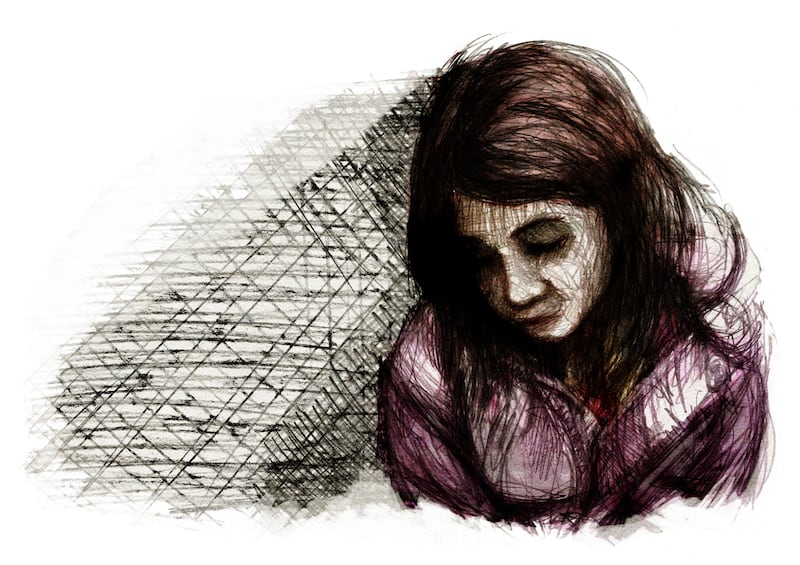
Layal is 11 years old and in fourth class at school. She has two brothers and a sister, their parents having been killed before their eyes.
Although Layal is supported by relatives she has assumed responsibility for her younger siblings. “I take care of my brothers and sister, and I want them to be educated,” the child says.
I don't know what I will do when I am 12 years old
“I will do everything they ask, and I will not leave them.” What of her own future? “It’s so far away,” she says. “I mean, now I am 11 years old, and I don’t know what I will do when I am 12 years old.”
Marc Corrigan: In the video interview I worked off, the girl rarely looked up towards the camera or made any eye contact at all. That was the idea behind this one. It's loosely based on her in the video, but it's more about how she carried herself, how she was. She rarely if ever looked up. She had her hands together on her lap, telling her story to the ground.
The displaced youth
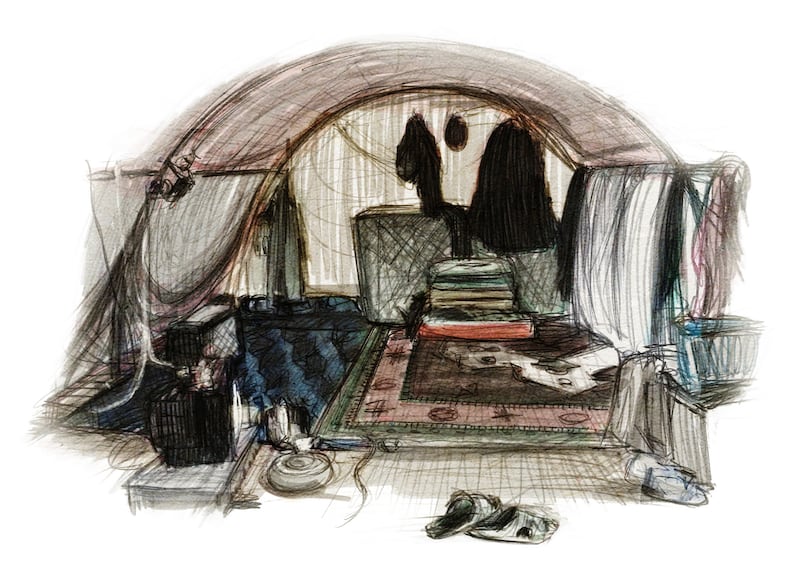
Twenty-year-old Marwan lives in a displaced people’s camp in northern Syria. Two and a half years ago his city was attacked, and his father disappeared. He and his two brothers have heard nothing since.
“We looked for him everywhere,” Marwan says, “but we couldn’t find him. He still hasn’t been found. The road to our home city is still closed, so we don’t know whether he is alive or dead.”
Every day I go to the city to look for a job, but I haven't found anything yet
After their father disappeared he and his brothers lived for a time with their grandparents. Life has been hard. “We were orphans living with our grandparents. We have experienced a lot of injustices since the start of the war. There was no food and we were often cold.”
Now the family is separated. Marwan’s brothers are in Turkey; he lives alone in a single tent. Finding work and making money are constant struggles. “We are now in the winter season, and I don’t have a job. Every day I go to the city to look for a job, but I haven’t found anything yet.”
Marc Corrigan: It was a very utilitarian scene: a canvas tent, blankets hanging up, some wires from a phone charger and a mattress. They seemed to make up his possessions. These were pencil-drawn, and then I coloured them digitally. I tried to unify a colour scheme across the drawings. They're muted colours. In this one I've taken the colours from the tent and muted them.
The widowed mother
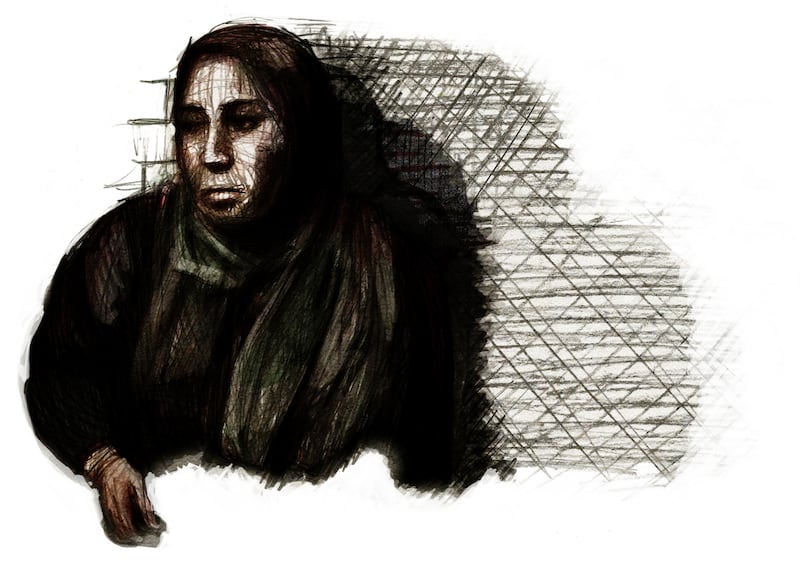
Fatima’s husband was killed along with all of his family in a massacre in their city a year and a half ago. “We woke up to the sound of bullets and very loud crashing noises,” she says, recalling the events leading to her husband’s death.
“My husband wanted to know what was happening – someone told him that his uncle had been killed – so he went outside on to the street. My children started grabbing on to me from fear and started crying. I went to look for him, and after a while I found him dead, with his family members.”
But, now, who can help me?
The family have been left traumatised by the death of their husband and father. “Since my husband was killed my children don’t want to speak, because they miss their father so much.”
Being a widow in a war zone is not easy. Fatima has a daily struggle to provide for her four children. “When my husband was working he could provide for our needs. But, now, who can help me?” she says.
“I have four kids. They can’t work. There are a lot of things they need, but I can’t provide for them. I depend on people’s help and on assistance provided by organisations. It’s hard, but I accept the help for the sake of my children. I have three daughters and a boy asking for things I can’t buy for them. I am afraid the aid will be cut off.”
Marc Corrigan: She seemed quite stoic. She told the story in a matter-of-fact way. Except for one moment, when she mentioned her husband and broke down. She was talking about her husband and having to take care of her kids on her own. There was a split second where it seemed to hit her. That moment was what I wanted to capture.
The fisherman’s family
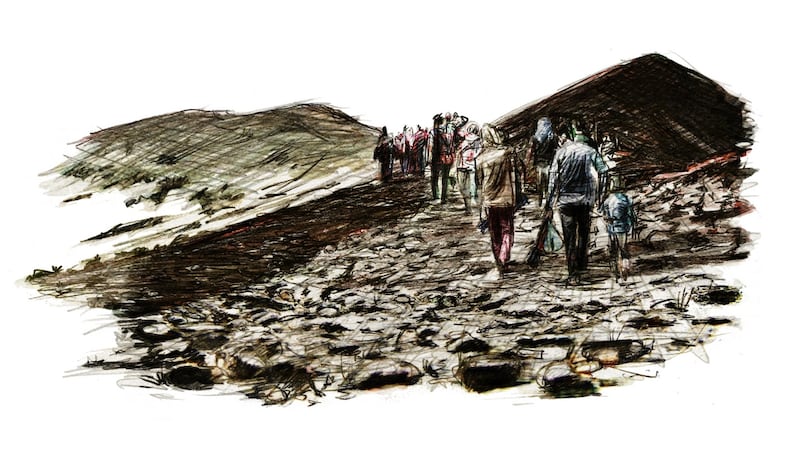
Fadil is a 36-year-old fisherman with 11 dependents: his wife, six young children, his two parents and two younger brothers. Late last year, fear of being forced to fight left Fadil’s movement very restricted.
“I became afraid to walk to the market,” he says. “I didn’t know what would happen. At any moment someone could have grabbed me and held me in confinement for any silly reason or forced me to take up arms.”
This meant he could no longer fish. With the cost of food and other essentials increasing, and bombardments becoming more frequent, the family made the difficult decision to leave.
I pray to God that this hateful war will end
The journey to the new city was long and arduous, and much of it was on foot, but they found help when they arrived. “When we first arrived in the new city Concern provided food baskets for us and registered us to receive food vouchers. We were so thankful.”
But life is still difficult and riven with fear. “My brothers are afraid of recruitment still, as they are of the right age,” he says. “They don’t go to the market, fearful of people and their agenda. I worry that fishing will not be enough to provide for my family.
“The market is not very good at the moment, and I don’t think we can cover all of our needs. Still, I am trying. And pray to God that this hateful war will end soon, so that I can return to my city again, where I know my neighbours.”
Marc Corrigan: In this case I worked off a transcript of the subject's interview. In the text he said they had paid people to move them to the next city and they hiked for days across rocky mountains. One of the kids twisted an ankle and had to be carried. It's as if we're at the same eye level as them. Looking at it, you're part of the same procession.
The female household
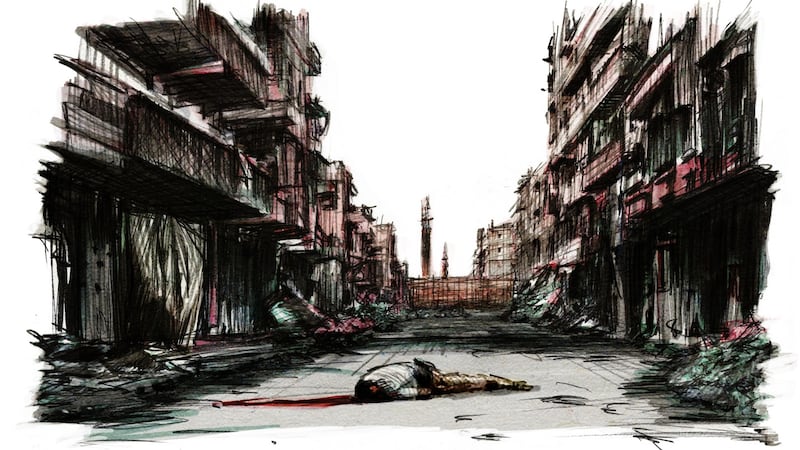
“We were very scared,” Sameh says, recounting the night her husband, Jalal, was killed. “I asked him to go see what was happening outside on the street. There was lots of noise, and we heard gunshots in the distance. He told me he didn’t want to go out, because he didn’t want to leave me and our daughters alone. But I told him not to be scared and to go out and look.”
Sameh pauses to take a breath as she remembers that evening. “He was killed that night while standing in the middle of the road. Then so many others were killed on that same road, out of nowhere. After that one moment we were all alone, without protection and without any reparation for our future.”
We live in a state of fear
Sameh is 40 years old, a widow and sole provider for five children and Jalal’s mother, Nawwar. The home they share has been badly damaged by shelling since Jalal died.
“We live in a state of fear,” Sameh says. “What if what happened to my husband happens to me? What will happen to my children and their grandmother? I am anxious all the time.”
The family’s vulnerability as a primarily female household is also a worry. The girls go to school not too far from the family home, but they tell their mother that they feel scared on the way.
“My husband used to talk about teaching the girls how to drive,” Sameh says. “But now those dreams are gone, along with him and along with all of his other dreams.”
Marc Corrigan: The widow told of hearing commotion on the street and asking her husband to go out to see what it was. He got shot. The story continued, but that image stuck in my mind. I gathered five or six street photos and worked from them. In my mind that's the aftermath; nobody else is coming out on the street. It's a graphic image, but then again it really happened. It happened many times. That's far more unpalatable.
The bereaved grandfather
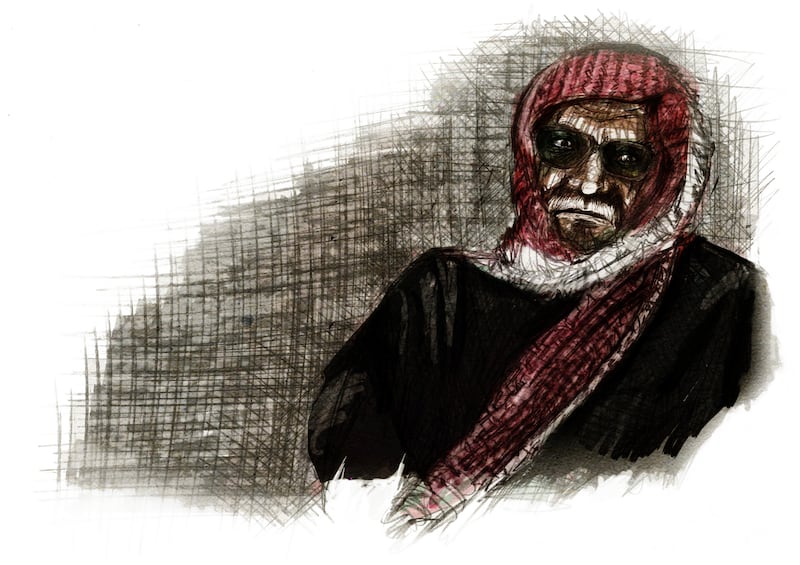
Ahmed Safar is 70 and a father of five children. His family has been destroyed by the war. Initially, two of his sons were kidnapped and killed by an armed group. A third son was later kidnapped and held for ransom.
Although Ahmed was a rich man before the war he was unable to raise the ransom within the 24-hour deadline, so this son was also killed. A remaining brother couldn’t accept what had happened to his siblings, couldn’t eat for a long time, got cancer and eventually died, a few months ago. Ahmed’s only daughter was also kidnapped and is missing.
A man who has lost all his children and is living with his young grandsons
Having been displaced six times in six years, he now lives with his young grandchildren in northern Syria.
“How can I explain what has happened?” he says. “It is a difficult situation to describe: a state of humiliation and suffering only God knows. What can a 70-year-old man say . . . a man who has lost all his children and is living with his young grandsons?”
Marc Corrigan: He was angry – a perfectly justifiable emotion. His sons had been killed, and he was living with his grandchildren. He had been wealthy and he lost everything. With the girl who never looked up, you felt nothing but sorrow for her. It was tragic. This man was just angry. It shows how people react in different ways.
These are edited extracts from Shattered Lives: Protecting Lives in War-Torn Syria – A Shared Responsibility, published by Concern. Marc Corrigan’s comments are drawn from an interview with The Irish Times. All names have been changed
*This article was amended on March 11th, 2017











